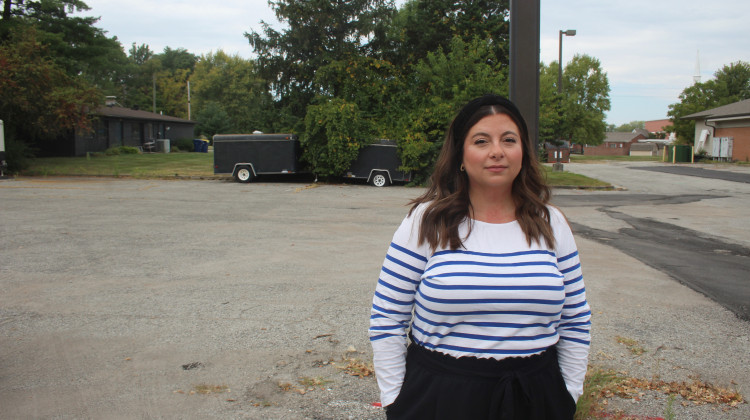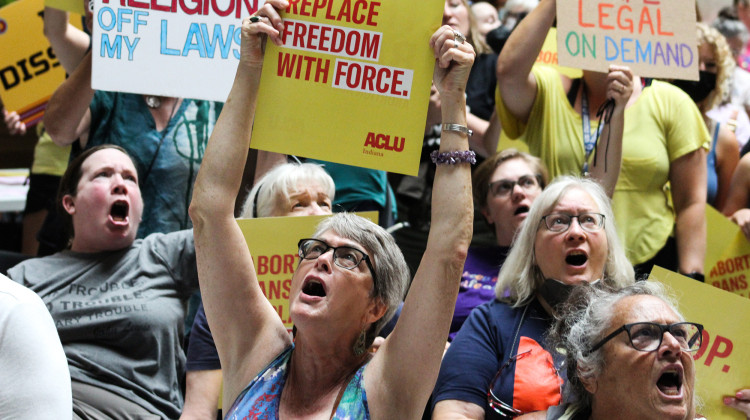
The WorkOne employment office in Elkhart County, one of many such centers that rely on federal WIOA funding across Indiana.
Justin Hicks/IPB NewsAt a hotel near the interstate in Elkhart, you might find Janet Reason serving drinks to business travelers in the lobby. She often starts up conversations with folks by asking what company they’re working with.
"The funny thing is when they say what company, I already know the HR’s [reps] name off the top of my head," Reason says.
She knows all their names because for the past five years she worked for the Northern Indiana Workforce Board. But earlier this year, on April Fool's day, everything changed.
Reason remembers being stunned when a human resources representative called her into an office and told her it was her last day. A few others were let go, too.
“She said you do your job so well," Reason says. "And it still hurts.”
Reason lost her job in part because of a mathematical formula. The federal government gives Indiana money which, in turn, flows to WorkOne employment offices. The higher the unemployment rate, the more money they get. So, when the unemployment rates dropped – so did the funding. Reason used to wonder if she was working herself out of a job.
"I remember sitting there going, great, we’re going to get cut," she says. "We just did such an awesome job. We’re going to get cut. I’m going to get cut. I’m the one of course.”
But it’s not just Reason who’s affected by shrinking workforce budgets. Indiana has 12 regional workforce boards going through the same thing. Many are cutting staff or moving and closing unemployment offices to save on rent. That means less support and less training for people needing help finding jobs.
Most of their money comes from a federal law called the Workforce Innovation and Opportunity Act, or WIOA, that gives millions of dollars to states each year. This is where that mathematical formula written into the law comes in again. Tom Kavanagh runs a Fort Wayne firm called JobWorks that counsels workforce boards across the country.

"The economy is doing so well, employers keep hiring people, and you’re left with low unemployment numbers," Kavanagh says. "The allocation is going to go down. It’s just the nature of the beast, if you will, of the formulas."
To be fairly distributed, the formula gives more money to states with more unemployed workers. Indiana’s steadily falling unemployment rate meant it got about $38 million this year, almost a third less than five years ago.
Kavanagh says it creates this system where people who need the most help getting employed are the only ones left and workforce boards need resources to help them land a job.
"I think that’s what you see today, with the low unemployment rate," he says. "You’re seeing individuals that aren’t in the workforce because they may have some of these other barriers that may be more difficult to overcome."
Kurt Kegerreis, executive director of the Southeast Indiana Workforce Investment Board, points to another issue with the funding model: it measures the needs of workers, but doesn’t measure the needs of the companies who need to hire them. And right now, companies say they need to hire a lot of workers.
"The formula is based on the concept that everything hinges on the needs of job seekers and if you don’t have a lot of job seekers out there then you don’t have a problem," Kegerreis says. "The truth is, go to any company right now and tell them that they don’t have a problem with talent. It is a crisis with talent and our employers are feeling that."
He compares workforce funding to defense spending. The federal government funds the military even when there isn’t a war so we can be ready in case there is. He says the same should be true of unemployment.
“And so what you end up having is an alarmingly underfunded system, which of course, is then going to be necessary when a downturn eventually hits,” he says.
Indiana’s workforce boards get a large amount of their funding from WIOA. If the unemployment rate stays low, U.S. Sen. Mike Braun (R-Ind.) says WorkOnes should find money outside of the federal government.
“I think it’s a questionable business partner," he says. "So I wouldn’t look to the federal government, I tell everyone that comes here [to Washington D.C.], many Hoosiers that are dependent on the place. I don’t see that it’s going to change drastically.”
Kavanagh adds that in another light, maybe the modest funding could present some opportunity for creativity in workforce efforts.
"I think the real challenge – and this is where the innovation and opportunity part of the act comes in – is really challenging workforce boards to think outside of just WIOA," he says.
Meanwhile, the Governor’s Workforce Cabinet is putting together their WIOA funding proposal for the next four years. They’ll submit it in early spring, but it won’t control how much they get. So for the time being, the unintended consequence of low unemployment may be a struggling unemployment system.
Economists warn another recession could be just around the corner. They say if it happens, it could happen quickly. What remains to be seen is if scaled back unemployment offices will be able to respond in time to get workers back on their feet.
Contact Justin at jhicks@wvpe.org or follow him on Twitter at @Hicks_JustinM.
 DONATE
DONATE









 Support WFYI. We can't do it without you.
Support WFYI. We can't do it without you.